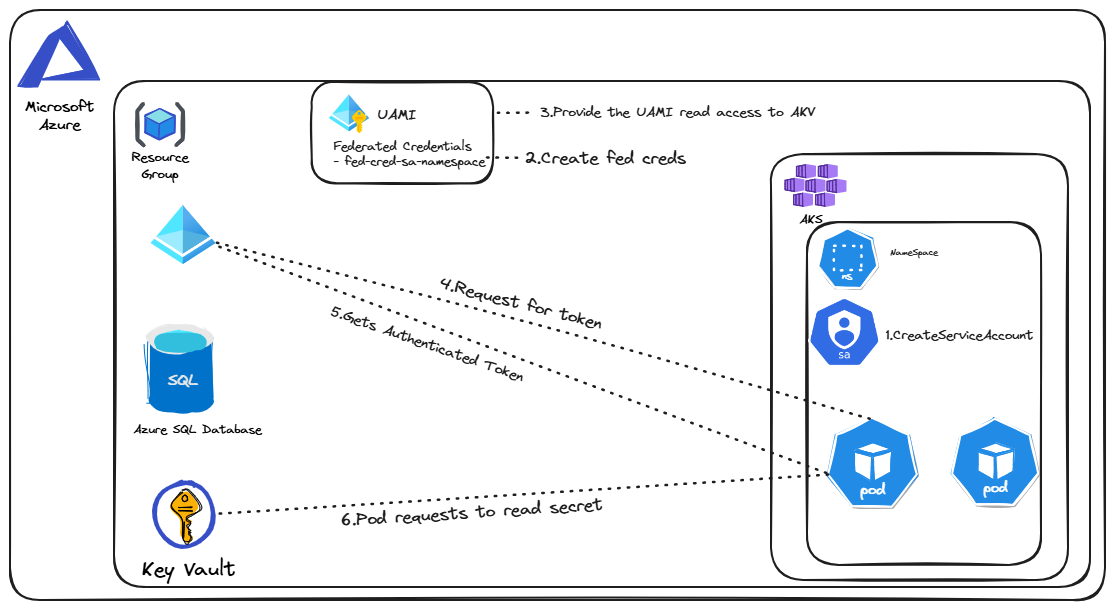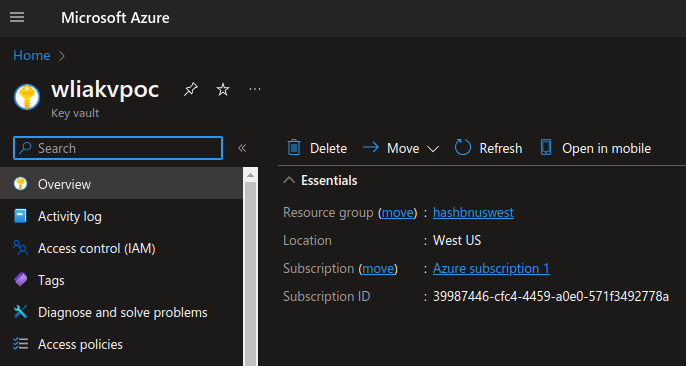Simplifying UAMI Integration with AKS and AKV
 Bipin Alchetti
Bipin AlchettiUse Case:
We have a token/secret stored in an Azure Key Vault secret
We have a pod in a Cluster that needs to read this secret.
We will use UAMI to enable the pod to read the secret stored in the AKV

Let's decode this in simple terms:
Pre-requisites: --> AKS cluster & Azure Cli 2.47.0 or greater
--> Bicep Scripts to create AKS & AKV
Lets enable the Workload Identity on the AKS Cluster
# Define RG & ClusterName export RESOURCE_GROUP="hashbnuswest" export CLUSTER_NAME="hashbnuswest" az aks update --resource-group "${RESOURCE_GROUP}" \ --name "${CLUSTER_NAME}" --enable-oidc-issuer \ --enable-workload-identityWhy do we need Workload Identity ?
As humans, we use our Azure credentials to access the AKV from the Azure portal.
As an application we use Service Principals to login to Azure and access the AKV contents provided access read/write .... access has been provided to the vault.
How does the pod authenticate itself, as it does not have an identity of its own as it resides inside the AKS Cluster, so let's use the native Kubernetes concept of ServiceAccount and connect it with UAMI in Azure.
Registering the Identity in Azure
Lets create a UserAssignedManagedIdentity (UAMI) in Azure
We create a Kubernetes Serviceaccount (SA) for the namespace in which the pod resides and reference the clientID of the UAMI.
# We need an UAMI resource to be created in Azure # which will be mapped to the service account in K8s export UAMI_NAME="UAMI_WL_IDENTITY" az identity create --resource-group $RESOURCE_GROUP \ --name $UAMI_NAME #Retrieve the clientID from the output or using below command export USER_ASSIGNED_CLIENT_ID="$(az identity show \ --resource-group "${RESOURCE_GROUP}" \ --name "${USER_ASSIGNED_IDENTITY_NAME}" \ --query 'clientId' --output tsv)" #Lets create the namespace in AKS export SERVICE_ACCOUNT_NAMESPACE="wlipoc" kubectl create ns $SERVICE_ACCOUNT_NAMESPACE # Lets create the ServiceAccount mapping it to ClientId of UAMI export SERVICE_ACCOUNT_NAME="workload-identity-sa" cat <<EOF | kubectl apply -f - apiVersion: v1 kind: ServiceAccount metadata: annotations: azure.workload.identity/client-id: "${USER_ASSIGNED_CLIENT_ID}" name: "${SERVICE_ACCOUNT_NAME}" namespace: "${SERVICE_ACCOUNT_NAMESPACE}" EOF # Output: serviceaccount/workload-identity-sa created
Create Federated Credentials to authenticate your workloads against IDP:
How do Federated Credentials work
# Lets fetch the OIDC URL export AKS_OIDC_ISSUER="$(az aks show --name "${CLUSTER_NAME}" \ --resource-group "${RESOURCE_GROUP}" \ --query "oidcIssuerProfile.issuerUrl" --output tsv)" # Lets create the federated credential export FEDERATED_IDENTITY_CREDENTIAL_NAME=wlipoc az identity federated-credential create \ --name ${FEDERATED_IDENTITY_CREDENTIAL_NAME} \ --identity-name "${UAMI_NAME}" \ --resource-group "${RESOURCE_GROUP}" \ --issuer "${AKS_OIDC_ISSUER}" \ --subject system:serviceaccount:"${SERVICE_ACCOUNT_NAMESPACE}":"${SERVICE_ACCOUNT_NAME}" \ --audience api://AzureADTokenExchange
Lets deploy the container using workload identity & verify WLI is enabled correctly
cat <<EOF | kubectl apply -f - apiVersion: v1 kind: Pod metadata: name: wlipoc-pod namespace: wlipoc labels: azure.workload.identity/use: "true" spec: serviceAccountName: workload-identity-sa containers: - name: alpine-container image: alpine command: ["/bin/sh", "-c", "--"] args: ["while true; do sleep 30; done;"] EOF # Verify if we have the below variables set inside the container kubectl exec -it wlipoc-pod -n wlipoc -- sh / # env | grep -i Azure AZURE_AUTHORITY_HOST=https://login.microsoftonline.com/ AZURE_CLIENT_ID=a5ed94d2-2380-40f3-882c-0a4f85d9ed18 AZURE_FEDERATED_TOKEN_FILE=/var/run/secrets/azure/tokens/azure-identity-token AZURE_TENANT_ID=2d8864a5-52db-4274-8d18-856d8d5caaf9 / #Lets now create an AKV with a secret using bicep --> akv.bicep
We have a UAMi which acts an identity for the pods in the namespace, so we have to give UAMI read secrets access to the AKV
#Fetching the principalID for the UAMI export IDENTITY_PRINCIPAL_ID=$(az identity show --name \ "${UAMI_NAME}" --resource-group \ "${RESOURCE_GROUP}" --query principalId --output tsv) # Azure Key Vault Name export KEYVAULT_NAME="wliakvpoc" # Fetching the resourceID for AKV export KEYVAULT_RESOURCE_ID=$(az keyvault show --resource-group \ "${RESOURCE_GROUP}" \ --name "${KEYVAULT_NAME}" \ --query id \ --output tsv) # Assigning the Key Vault Secrets User to UAMI to read the secrets az role assignment create --assignee-object-id \ "${IDENTITY_PRINCIPAL_ID}" --role "Key Vault Secrets User" \ --scope "${KEYVAULT_RESOURCE_ID}" \ --assignee-principal-type ServicePrincipalLets deploy a sample container which has code to read the secrets from the AKV
# AKV URL would be needed by the container to access the AKV export KEYVAULT_URL="$(az keyvault show \ --resource-group ${RESOURCE_GROUP} \ --name ${KEYVAULT_NAME} --query properties.vaultUri --output tsv)" # Defining the secret-name which we had created using the bicep file export KEYVAULT_SECRET_NAME=my-secret # Sample Container yaml using the image which would be able to connect # to AKV and read the secret cat <<EOF | kubectl apply -f - apiVersion: v1 kind: Pod metadata: name: sample-workload-identity-key-vault namespace: ${SERVICE_ACCOUNT_NAMESPACE} labels: azure.workload.identity/use: "true" spec: serviceAccountName: ${SERVICE_ACCOUNT_NAME} containers: - image: ghcr.io/azure/azure-workload-identity/msal-go name: oidc env: - name: KEYVAULT_URL value: ${KEYVAULT_URL} - name: SECRET_NAME value: ${KEYVAULT_SECRET_NAME} nodeSelector: kubernetes.io/os: linux EOF
Lets verify whether the container is able to fetch the secrets
kubectl get pods -n wlipoc NAME READY STATUS RESTARTS AGE sample-workload-identity-key-vault 1/1 Running 0 7s wlipoc-pod 1/1 Running 0 117mkubectl describe pod sample-workload-identity-key-vault -n wlipoc \ | grep "SECRET_NAME:" SECRET_NAME: my-secretkubectl logs sample-workload-identity-key-vault -n wlipoc I0622 15:24:34.752062 1 main.go:63] "successfully got secret" secret="hellowwss" I0622 15:25:34.824601 1 main.go:63] "successfully got secret" secret="hellowwss"
References:
Subscribe to my newsletter
Read articles from Bipin Alchetti directly inside your inbox. Subscribe to the newsletter, and don't miss out.
Written by

